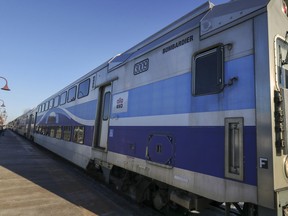In an exclusive interview, Stéphane Yelle says he expects ridership to suffer when the REM is implemented.

The future of the region’s most-popular train line is in doubt as planners expect the Vaudreuil-Hudson route will lose up to 20 per cent of its riders when the REM is implemented.
“If there is a reduction in the ridership, there will necessarily be a cut in service,” Junca-Adenot said. “The government is not in the habit of compensating transit agencies for loss of revenue.”
She criticized the initial planning of the REM’s network.
“You’re not supposed to build transit lines without having an overall vision, and it has to be coherent and not compete with other services,” she said. “But in the case of the REM, this was imposed without consultation, no analysis, and it wasn’t foreseen in the strategic plan for the region.”
Making matters worse, long-discussed projects to boost service and make the Vaudreuil-Hudson line more attractive have been placed on hold indefinitely. They include adding a third track to the portion near the Dorval station to allow more departures and adding a train leaving from downtown’s Windsor Station at the end of the night for those attending Montreal Canadiens games or otherwise enjoying the city’s nightlife. Yelle said such projects are on hold until there is a proven increase in ridership to justify such investment.
He said he’s not concerned for the long-term viability of the train because he believes after the initial hit in riders, there will be an increase, noting that the Vaudreuil-Dorion area is still growing.
“We have to look at this on a long-term basis,” he said. “There is still a lot of potential with Exo’s train service.”
He also noted that the Exo trains all having large parking lots around them, which is not the case with the REM.
Yelle added the REM is good news for transit in general because it will attract new public transit riders. They will use all forms of transit, so the money they spend on monthly passes will be shared among all the operators.
Junca-Adenot pointed out, however, the REM also adds many costs to the transit network on the whole. The REM’s owners charge the ARTM based on the number of riders it shuttles, an amount expected to reach roughly $300 million per year — money that is currently not in the ARTM’s existing budget. That means the more people use the REM, the more it will cost the ARTM at the end of the day.
Despite her pessimism, Junca-Adenot believes it is too soon to make drastic changes to the Vaudreuil-Hudson line’s service, saying planners should wait to see the full impact of the REM before deciding on long-term plans.
A transit lobby group agrees.
Blaise Rémillard, a spokesperson for CRE-Montréal, hopes the province steps in to compensate the transit operators for the loss of revenue as a result of the REM.
“I think we will have to get used to living with a suboptimal ridership for a long time to come, but it will pay off in the long term,” he said. “It’s sure that in the coming decades, ridership numbers will return as we see even greater traffic congestion. I think it is worth it to invest in these lines.”
He added it would be far costlier to cancel any of the lines, especially if the government elects to restart a similar service.